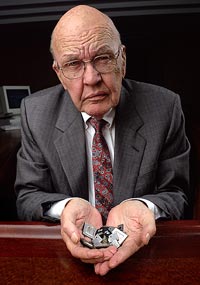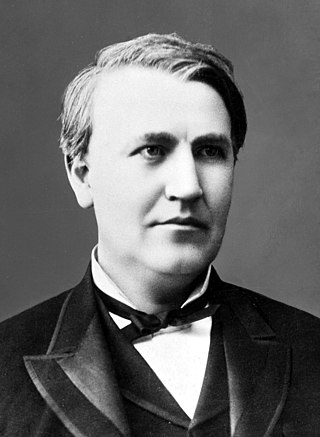Related Research Articles

Charles Proteus Steinmetz was an American mathematician and electrical engineer and professor at Union College. He fostered the development of alternating current that made possible the expansion of the electric power industry in the United States, formulating mathematical theories for engineers. He made ground-breaking discoveries in the understanding of hysteresis that enabled engineers to design better electromagnetic apparatus equipment, especially electric motors for use in industry.

Jack St. Clair Kilby was an American electrical engineer who took part, along with Robert Noyce of Fairchild Semiconductor, in the realization of the first integrated circuit while working at Texas Instruments (TI) in 1958. He was awarded the Nobel Prize in Physics on 10 December 2000.

Elihu Thomson was an English-born American engineer and inventor who was instrumental in the founding of major electrical companies in the United States, the United Kingdom and France.

The war of the currents was a series of events surrounding the introduction of competing electric power transmission systems in the late 1880s and early 1890s. It grew out of two lighting systems developed in the late 1870s and early 1880s; arc lamp street lighting running on high-voltage alternating current (AC), and large-scale low-voltage direct current (DC) indoor incandescent lighting being marketed by Thomas Edison's company. In 1886, the Edison system was faced with new competition: an alternating current system initially introduced by George Westinghouse's company that used transformers to step down from a high voltage so AC could be used for indoor lighting. Using high voltage allowed an AC system to transmit power over longer distances from more efficient large central generating stations. As the use of AC spread rapidly with other companies deploying their own systems, the Edison Electric Light Company claimed in early 1888 that high voltages used in an alternating current system were hazardous, and that the design was inferior to, and infringed on the patents behind, their direct current system.

Robert Heath Dennard is an American electrical engineer and inventor.
This is an alphabetical list of articles pertaining specifically to electrical and electronics engineering. For a thematic list, please see List of electrical engineering topics. For a broad overview of engineering, see List of engineering topics. For biographies, see List of engineers.
Edmund O. Schweitzer III is an electrical engineer, inventor, and founder of Schweitzer Engineering Laboratories (SEL). Schweitzer launched SEL in 1982 in Pullman, Washington. Today, SEL manufacturers a wide variety of products that protect the electric power grid and industrial control systems at its five state-of-the-art U.S. manufacturing facilities in Pullman, Washington; Lewiston, Idaho; Lake Zurich, Illinois; West Lafayette, Indiana, and; Moscow, Idaho. SEL products and technologies are used in virtually every substation in North America and are in operation in 164 countries.

Charles LeGeyt Fortescue (1876–1936) was an electrical engineer. He was born in York Factory, in what is now Manitoba where the Hayes River enters Hudson Bay. He was the son of a Hudson's Bay Company fur trading factor and was among the first graduates of the Queen's University electrical engineering program in 1898.
Charles Francis Avila was an American electrical engineer and a Vice President and a member of the Executive Committee of the Yankee Atomic Electric Company.

A pothead is a type of insulated electrical terminal used for transitioning between overhead line and underground high-voltage cable or for connecting overhead wiring to equipment like transformers. Its name comes from the process of potting or encapsulation of the conductors inside the terminal's insulating bushing.
James R. Wait was a Canadian electrical engineer and engineering physicist. In 1977, he was elected as a member of National Academy of Engineering in Electronics, Communication & Information Systems Engineering for his contributions to electromagnetic propagation engineering as it affects communication and geophysical exploration.
Michael Athans was a Greek-American control theorist and a Professor Emeritus in the Department of Electrical Engineering and Computer Science at the Massachusetts Institute of Technology. He was a Fellow of the IEEE (1973) and a Fellow of the AAAS (1977). He was the recipient of numerous awards for his contributions in the field of control theory. A pioneer in the field of control theory, he helped shape modern control theory and spearheaded the field of multivariable control system design and the field of robust control. Athans was a member of the technical staff at Lincoln Laboratory from 1961 to 1964, and a Department of Electrical Engineering and Computer Science faculty member from 1964 to 1998. Upon retirement, Athans moved to Lisbon, Portugal, where he was an Invited Research Professor in the Institute for Systems and Robotics, Instituto Superior Técnico where he received a honoris causa doctorate from the Universidade Técnica de Lisboa in 2011.
Arun Phadke is a University Distinguished Research Professor in the Department of Electrical and Computer Engineering at Virginia Tech. Along with fellow Virginia Tech professor James Thorp, Dr. Phadke received The Franklin Institute's 2008 Benjamin Franklin Medal in Electrical Engineering for their contributions to the power industry, particularly microprocessor controllers and Phasor measurement unit (PMU) technology in electric power systems.

Siva Subrahmanyam Banda is an Indian-American aerospace engineer. He is Director of the Control Science Center of Excellence and Chief Scientist for the Aerospace Systems Directorate at the United States Air Force Research Laboratory at Wright-Patterson Air Force Base. He has taught at Wright State University, the University of Dayton, and the Air Force Institute of Technology.
Bantval Jayant Baliga is an Indian electrical engineer best known for his work in power semiconductor devices, and particularly the invention of the insulated gate bipolar transistor (IGBT).
Robert H. Park was an American electrical engineer and inventor, best known for the Park's transformation, used for simplifying the analysis of three-phase electric circuits. His related 1929 concept paper ranked second, when looking at the impact of all twentieth century power engineering papers. Park was an IEEE Fellow and a member of the National Academy of Engineering.
Sudip K. Mazumder is a UIC Distinguished Professor and is the Director of Laboratory for Energy and Switching-Electronics Systems (LESES) in the Department of Electrical and Computer Engineering at the University of Illinois Chicago (UIC), which he joined in 2001. He has over 30 years of professional experience and has held R&D and design positions in leading industrial organizations, and has served as technical consultant for several industries. He also serves as the President of NextWatt LLC since 2008.
Bruno Murari is an Italian inventor. During his career he has patented about 200 inventions in the field of circuit design, power technologies and MEMS devices. He is the only Italian to have received the Elmer A. Sperry Award., which is awarded to those who have distinguished themselves with proven engineering contributions to advance the field of transport. He was defined "legendary analog engineer" and "father" of the BCD technology
Thomas H. Lee was a Chinese-American electrical engineer and writer. He worked for General Electric for 30 years, where he developed the first practical vacuum interrupter and the silicon rectifier in the 1960s. In the 1980s he served as the Philip Sporn Professor of Energy Processing at the Massachusetts Institute of Technology and co-chaired the MIT Sloan School's Management of Technology program. He was elected a member of the National Academy of Engineering in 1975 and a foreign member of the Chinese Academy of Engineering in 2000. He was an IEEE Fellow and received the IEEE Haraden Pratt Award in 1983.
References
- 1 2 "Power Cable Reliability Expert to Receive 2010 IEEE Herman Halperin Electric T&D Award". Mar 10, 2010 T&D World Magazine
- ↑ Electrical Insulation. IEEE. 1998. ISBN 9780780349285.
- ↑ "Submerged Medium Voltage Cable Systems at Nuclear Power Plants". Jason Brown, et al, Sandia National Laboratories
- ↑ IEEE ... Transmission and Distribution. IEEE. 1991. p. 36. ISBN 9780780302198.
- ↑ RSC. Railway System Controls. Simmons-Boardman Publishing Company. 1975.
- ↑ "Bruce McLaughlin Launches RERC: Wind Farm Investment Consultants - BioFuels Journal" . Retrieved 29 May 2016.
- ↑ "Katz named chief research engineer at General Cable's Power and Research Control Center". Wire Journal. Wire Journal, inc. 1975. p. 15.
- ↑ "News".
- ↑ Public Power. American Public Power Association. 1986.
- ↑ Katz on a Wire – The IEEE Award Winner Talks Cable – Utility Products Magazine
- ↑ United States. Patent Office (1974). Official Gazette of the United States Patent Office: Patents. The Office.
- ↑ "Patent US3825670 - Connector for use in capacitive graded splices" . Retrieved 29 May 2016.
- ↑ IEEE Power Engineering Society (1978). IEEE Power Engineering Society discussions and closures of abstracted papers from the summer meeting, Mexico City, Mexico, July 17-22, 1977. Institute of Electrical and Electronics Engineers.